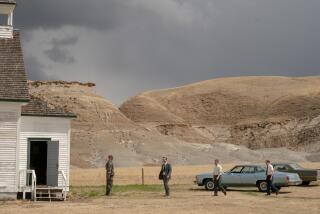Oscar Orphan? : Some Academy voters may stay away from the two-part, 6-hour ‘Little Dorrit’
- Share via
If you judge by decades of past performance, you might make a nickel bet right now: That the film of greatest potential interest to the voting membership of the Academy of Motion Picture Arts and Sciences this year will go unseen by them.
“Little Dorrit” is hardly an unheralded film, either here or in Great Britain where it was made. The maverick qualities of its makers, and particularly its almost unknown director/adapter, Christine Edzard, has been described by articles both here and in New York. Newsweek, in recommending it, called it “the first postmodern Dickens, a Dickens for the uncertain end of a chaotic century.”
In Great Britain, Lord Snowdon has done an entire portfolio of its characters, 20 color portraits of Alec Guinness, Derek Jacobi, Joan Greenwood, Sarah Pickering, Roshan Seth, Eleanor Bron, Miriam Margolyes, Cyril Cusack, Murray Melvin, Robert Morley, Max Wall, Sophie Ward and more of the principals of its cast of 250. The Museum of London put its costumes on exhibition, an unprecedented move which becomes understandable when you see the film. Because director Edzard believes that actors stand and sit and behave differently when their clothes are authentic, the costumes, the bonnets, even the corsets were hand-sewn, copied down to the smallest detail from clothes of the 1840s.
But with the same tenaciousness that got “Little Dorrit” made at all, Edzard also chose an unconventional way to frame her teeming love story. It is conceived as a major film in two parts--six hours in all. The two sections work independently, but to get the full resonance, a sort of psychological stereo effect in which even the sets and costumes are subtly altered in each person’s viewpoint, you should see both parts, “his” story and then “hers.”
Well, six hours. That’s a pretty steep investment of time, especially during a holiday season. Academy members won’t be seeing it after dinner at one another’s houses. It requires something from an audience.
What makes it ironic is that the same audience who probably won’t stir themselves to get out to “Little Dorrit” at its sole commercial location (the Goldwyn Pavilion Cinemas, Westside Pavilion) were just the ones besieging every ticket broker to get in to the 8 1/2-hour, ground-breaking stage production of “Nicholas Nickleby.” But that was 1981; this is now, at the end of a notably phlegmatic decade.
A certain cachet came with having seen the Royal Shakespeare Company’s “Nickleby,” with having paid $100 for your ticket and devoting a full day or two nights to the enterprise. For one thing, it was live, and at some point, the company would go back to London. That put just enough of an edge of panic to the project to drive New Yorkers and bicoastalers to a ticketing frenzy.
A film is different, particularly in this city. Here films are regarded as commodities that appear on demand and absolutely at one’s own convenience. In order to get Academy members’ attention, you have to screen a movie over and over and over again. Most of all, it has to appear in-house at the Academy itself, on their Saturday and Sunday members-only screenings. At this writing, “Little Dorrit” hasn’t made that crucial list. Certainly, its length makes it tricky, although certainly not impossible. But even if it were screened, there’s still the inertia that has built up in a membership used to being importuned and catered-to at every turn. Don’t bet that Academy members can reverse themselves so quickly.
If they did, of course, they might find a film exquisitely to their tastes, a pungent, hilarious film with a lovely intelligence radiating from both sides of the camera.
It’s safe to say that Alec Guinness’ William Dorrit is the towering achievement of his later years. Watching Guinness’ infinitely subtle shadings, the bite he can put on a single word (even an epical one like “Parricidal!”) and you know you’re watching the distillation of a lifetime’s work.
Well-born but shut up in the Marshalsea debtor’s prison for 23 years, Dorrit is a man of bogus grandeur. It doesn’t distress him to have his tiny Marshalsea-born daughter, Amy, lug the heavy copper kettle to make his tea; it distresses him to have others see her doing it. Shameless, helpless, pretentious, his behavior in front of visitors from “outside” is a kaleidoscope of self-deprecation as he cadges handouts that he loftily calls “testimonials” to his position as “the father of the Marshalsea.”
Literary critics have speculated that the richness of the character came from first-hand observation: When Dickens’ own father spent a three-month sentence in the Marshalsea, his family, including 12-year-old Charles, accompanied him. But Dickens’ biographer Edgar Johnson sees Dorrit as “an amazingly brilliant feat of independent character creation” rather than a copy of John Dickens. Whatever his source, he achieves immortality in Guinness’ hands.
Jacobi plays Arthur Clennam, the story’s hero and a man closest to Dickens’ perception of himself at 45, as a man prematurely old who had missed his chance at happiness. Actually, Jacobi’s role is tricky; in the shadow of a character like William Dorrit, a linchpin like Clennam can seem dull, always acted-upon, rarely acting. But Jacobi hasn’t a dull instinct in him; he gives Clennam such depths of intelligence, wistfulness and compassion that even Clennam’s later, terrible missteps of judgment can be understood and forgiven. (Audiences may be piqued by knowing that only months after finishing “Little Dorrit,” with its love story between Clennam and a child-heroine, Dickens fell in love with the 18-year-old Ellen Ternan, an actress who was finally to become his mistress.)
But the film doesn’t hang on two superstars. “Little Dorrit” is what it is because of every extraordinary, evocative face and every one of its singular character actors, some of Britain’s best. Miriam Margolyes is probably not known to many Americans yet, but her performance as Arthur’s gone-to-seed first love Flora Finching, now a lady of tea-cozy proportions, is a hilariously deadly mixture of madness, spirit and bravura technique. Roshan Seth’s Mr. Pancks, with his hair oiled into prongs so that it looks just like a Cruikshank illustration of the period, is a ferociously fine performance. And although Cyril Cusack, playing Dorrit’s self-effacing brother Frederick, has only a handful of lines, he remains an indelible character, a man whose one sigh at a deathbed scene becomes a grace note to an entire life.
And so the film goes, through some of Dickens’ greatest satiric creations: Mrs. Merdle, Tite Barnacle, and that tribute to ultimate bureaucracy, the Circumlocution Office, which Edzard renders as a blend of Kafka and Alice in Wonderland.
You have to wonder--will this deliciously civilized savagery ever be seen by the audience who might appreciate it most? This audience whose voice can be heard around the world? To do that, Academy members would have to free themselves from the pleasant languor of “Sounds interesting . . . let someone else see it.”
Well, they shouldn’t feel alone in their torpor. They have a perfect match in “Little Dorrit’s” releasing company, Cannon, whose aim seems to have been to keep their most prestigious release a complete secret, other than three weekends of Academy screenings in early December. Months ago in the phone book size MIFED issue of weekly Variety, you could thumb through glowing two-page full-color ads for such Cannon prides as “Cyborg” and “Rockula” (and, one admits “A Cry in the Dark”), before finding their notice of “Little Dorrit.” Exactly one-half page. Talk about a cry in the dark. Parched audiences deserve better. So, for that matter, does “Little Dorrit.”
More to Read
Only good movies
Get the Indie Focus newsletter, Mark Olsen's weekly guide to the world of cinema.
You may occasionally receive promotional content from the Los Angeles Times.










